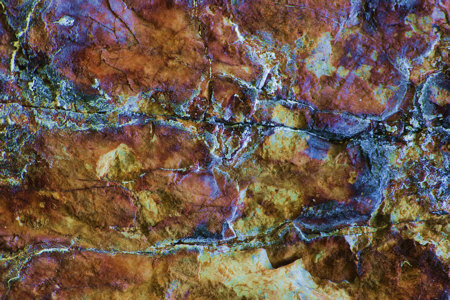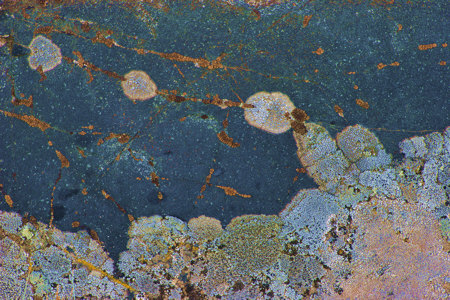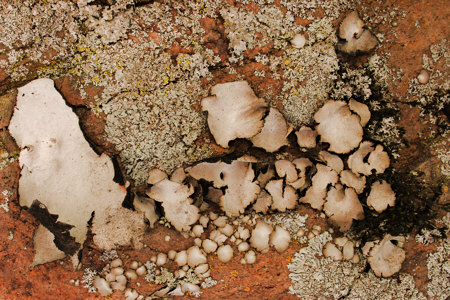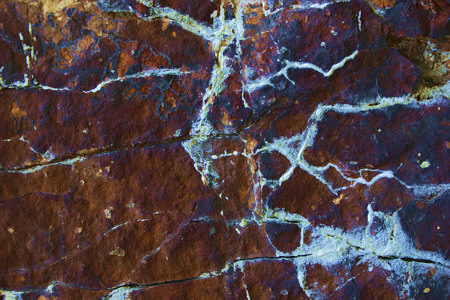
Karl asked me last week: What am I trying to say with my Patina photographs of old paint on old cars? Within the context of what I had just been doing — starting to work with strong color and abstract patterns — I quite honestly answered that I didn’t know. But to work with the images, I had to retrieve them from a computer directory “Junkyard cars” that was paired with another one, both under the rubric “Patina-Altered Surfaces.” It wasn’t until browsing later that I was reminded of that second directory called “Rocks.”

I think it was at most a couple days after my first junkyard foray last summer that I was hiking in the mountains and the full project came to me. It was revealed on a rock, graven by sun and rain, lichens and other organisms. I realized that all around me were rock surfaces altered by chemical and biological weathering. Though the substrates and mechanisms were different, the results could be intriguingly similar to the car paint. My project would be to illustrate that comparison. Not in a scientifically precise way, but hopefully in an artistically satisfying way.

This idea pleased me very much. Although I was fascinated with the weathered paint, I didn’t want to just do the same kind of series as many other photographers have done. The connection between man and nature, machines and minerals, gave the idea some weight and made it different enough to seem new. Most likely something like it has actually been done before, although I don’t count those vast compilations of patterns on every conceivable surface. If it, then I’d like to know, but I’m still pretty sure mine will be different somehow. Guess it’s that vanity Rex talked about.

I have to admit I feel a tinge of uneasiness laying out my idea here for all the world. Even though it’s not exactly earth-shaking, a part of me wants to keep it secret until it has come to fruition. What if somebody else runs with it and gains fame and fortune before I do?! But I’ve decided that if anyone wants it, I’ll wish them good luck and good work. Not all ideas want to be shared, but I’m willing to let this one go.

In any case, I’m still a long way from knowing clearly what I want to say with this project. I just have a hazy outline of a concept. That’s what the project is for, to wander through the haze and discover what, after all, I might wish to say. And simultaneously, as these things tend to go, how to say it. Maybe discussions with you will help me get there.
How do you get your ideas? Do you keep them secret for a while?

Steve,
My dad used to be a molecular biologist back in the heroic days when the structure of DNA had recently been discovered. A pair of scientists found that if they put RNA molecules into the appropriate biological system, it “stimulated” protein synthesis. These scientists felt that their discovery was so important that it should be kept secret. In fact, their discovery was far more important than they realized. They had in fact discovered the first piece of the genetic code, or at least they had the information in their data. Unfortunately, they never thought of looking for that information, and later other scientists won the Nobel prize for the discovery. According to my dad, if the secretive pair had shared their result and presented it for discussion, the interaction would immediately have led them to realize the significance of their work.
My father also made a discovery about the genetic code, the last codon rather than the first. He shared the result with some colleagues, and in the event, they published the discovery first. If ever there were a reason to feel a risk about revealing ideas too early, this is it. Still, he stays with the philosophy that to share ideas is more profitable than to keep them secret.
So, my dad would approve. Anyway, I’m off to photograph some cars and rocks. Good luck with your post ;-)
Steve, you’ve given me a great idea for a series of photographs. It’s called “art theft”, and my first photo is going to be of Karl photographing cars and rocks :)
Personally, I wouldn’t worry too much about people stealing your ideas. I mean, I think it’s premature to talk about them before you’ve done the work, but posting them online along with your photographs is a way of making your mark.
At some point you’ve got to put your stuff out there if you want it to be seen. Chances are there are people working with concepts similar to anything any of us are doing anyway. The key is in realizing those ideas in a thorough and compelling way. If the idea is good enough, people probably will copy it, and by then you’ll be onto something else, or at least a more advanced stage of your project.
Steve,
What about doing this with close up photos of people as well?
Steve,
You are on a roll. The only reason not to talk about the process is if the talk takes the place of going on with the process. I’m into the Commons idea, myself, and Karl’s dad’s stance makes me feel good about the world in general.
But Karl, when you suggested Steve might do close-ups with people, I shuddered and trembled and shook. I’m doing a studio oil class and tonight we begin our self-portraits. I’ve been looking at myself and noticing a certain patina of age, of nature overcoming nurture, of “surfaces altered by chemical and biological weathering.” In short, I would make a great subject for Steve, if he can find me in my hiding place under the bed.
David, you’re going to have a little trouble carrying out your series, given you’re on a different continent from Karl. Leaving the obvious pun to you…
Yes, the people close-ups could be a little scary.
Steve, my brain is a little fuzzy this morning, so the pun is absent. Go for it…
Steve,
It is precisely the challenge of the human closeups that could make the series complete. It is the logical extension of your idea.
Here is why I think it is important. We are living in a time when we don’t know when the lunatics running America are going to bomb another country and start the next conflagration. This is a time of war and tension. Somehow, photos of rocks and auto junk are not enough. They are not an escape from reality, but as reality they are not challenging enough to distract me from what I read in the newspaper. The dead rabbit, the photo graffiti, these were subjects with inherent tension, doses of reality suitable for today.
Not that you have to worry what I think, of course, but it might be an indication of a more general feeling.
Karl,
Having discarded my brilliant satirical political/aesthetic riposte to your comment, I have to admit you have a point. I think tension in some form is a really important aspect of an artwork, and I agree that it’s largely lacking in these images. At least, I’m not really feeling it myself. That’s a big part of what I’m searching for. In other words, I won’t know what I “want to say” until I encounter some harder edge that tells me, “here is something worth saying.” It may come out of the confrontation between the mode of aging/breakdown between modern/artificial and ancient/natural, or it may come from elsewhere. It might be something I would consider political, but then again it might not. I would say it has to relate to some aspect of human emotion or concern.
Now that we have that straight, I have to say I am really getting to like these photos. Amazing how one needs to grow into artwork, isn’t it?
Steve, don’t listen to people like me (except for the next few words). I think you are onto something really good here. What I like best is that it is unforced.
I love your pictures too. Have you thought of ‘jazzing up the colors’ of the rock with lichen?
They are jazzed up! But not as much as some, I like them somewhat muted. I think some of the others are also too strong as presented. That’s something I’m trying to get a feel for. Do you like colors that are clearly hyper-real better than ones that might be possible in reality? Does the uncertainty of not knowing whether coloring is real or enhanced bother anyone?
Does the uncertainty of not knowing whether coloring is real or enhanced bother anyone?
Doesn’t bother me a bit.
Steve,
I can’t wait for June’s version of these images in textiles :)
They are really gorgeous and I appreciate your willingness to share your ideas as I was feeling a bit stuck :)
No, really, sharing gestating ideas is scary for me too. Not for fear of them being stolen but for fear that soemone will tell me they are dumb, hackneyed, cliche, idiotic, or worst of all, boring. When I am playing with baby ideas I often do not want any feedback because they are so, well, babyish. the more obvious ones come out first and they are often cliche or simplistic. Before I get feedback I want to develop them more. I even have to quiet my own inner critic before she decides to stamp out my ideas before I get to try them out! I am all about mass production and then editing out. It seems like photography could really lend itself to that kind of creative process, but some people can’t stand not knowing ahead of time exactly what will come out and its purpose, etc.
Your ideas are not simplistic. they are the beginings and you don’t know where they will take you. And that is exciting to witness.
Leslie,
Thank you for actually saying something about your idea process! I suspect most art has some idea behind it, even if it is not at all “conceptual” as art. After all, how do you decide what to start doing when you pick up your brush, camera, whatever? But I’m sure that the process can start from very vague beginnings. It’s interesting how those get refined as the work progresses. I suspect that if that doesn’t happen–if the artist never gets a more or less defined idea–then the work fails somehow. Again, by “idea” I don’t necessarily mean a specific “message,” but just a sense that yes, this is what I want to do. Does that make sense?
And I agree that a number of these are quite reminiscent of June’s fabulous fabric designs.
Hm, Steve,
You did say, steal these visions, didn’t you? Maybe I’ll have to come out from under the bed to use them. Oh, right, it was “Steal this Idea,” and, as we know, ideas aren’t copyrightable (I think).Nor nearly as fascinating as the images themselves.
Actually, I don’t think your photos would be reproducible in textiles, although like Lesley, it’s fun to think of them in silk. There’s an intimacy of detail that photos can capture that neither paint nor dye nor even photos-on-silk can emulate with any success. Sui generis. Nice stuff.
I also think that the process of making art is a bit like running randomly, circling something that you can’t even define. First a nibble of an idea, then an image, then a bigger nibble, then a slightly altered direction and another image then a reversal and a swerving back and yet another image (some of these images are real; others just imagined). For me, it’s as if I can’t do it all at once. The circling and doing and redoing and thinking and dreaming and doing again all seem to be random when I’m doing it, but in the end, I find myself (sometimes, anyway) knowing what it is that I’ve been doing all along. And at that point, I can sharpen all my tools and get that final edge. When I don’t come to the point of a “more or less defined idea,” then I generally throw whatever I’ve done into a basket where it remains until I throw it into the trash.
Steve
I think that revealing you ideas can be a scary place – allowing others to see your concept before you’ve arrived at the final destination. Then again, don’t we “check-out” or “test-drive” our ideas with friends in other aspects of life? Is it different with art? And if so, why should it be?
Come to think of it, I don’t tend to talk about my ideas. Instead I tend to emerge at the end of the process, a bit like from a meditation.
David:
How’s the Art Theft project going?